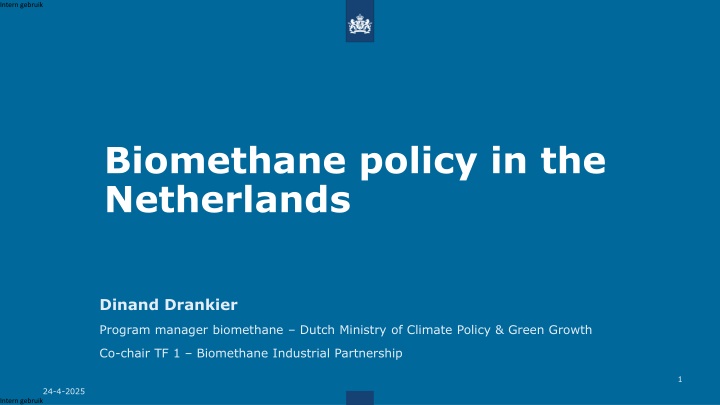
Biomethane Policy Upscaling Challenges and Solutions
Learn about the challenges and interventions in upscaling the biomethane policy in the Netherlands, including reasons for upscaling, contributions of biomethane, and the policy program's challenges and instruments. Discover how the Biomethane Program aims to increase production and address barriers for the sustainable use of biomethane in energy systems.
Download Presentation

Please find below an Image/Link to download the presentation.
The content on the website is provided AS IS for your information and personal use only. It may not be sold, licensed, or shared on other websites without obtaining consent from the author. If you encounter any issues during the download, it is possible that the publisher has removed the file from their server.
You are allowed to download the files provided on this website for personal or commercial use, subject to the condition that they are used lawfully. All files are the property of their respective owners.
The content on the website is provided AS IS for your information and personal use only. It may not be sold, licensed, or shared on other websites without obtaining consent from the author.
E N D
Presentation Transcript
Intern gebruik Biomethane policy in the Netherlands Dinand Drankier Program manager biomethane Dutch Ministry of Climate Policy & Green Growth Co-chair TF 1 Biomethane Industrial Partnership 1 24-4-2025 Intern gebruik
Intern gebruik Reasons for upscaling biomethane Climate and energy Nature, environment and agriculture 228 Mton 19 Mton 124 kton GHG reduction CH4 reduction NH3 reduction -30% -X%* -55% 0 Mt 2050 1990 2020 2030 1990 2020 2030 1990 2020 2030 Contribution biomethane Production of 2 bcm 3,6 Mton GHG reduction Reinforcing security of supply Decarbonization of hard-to-abate sectors Contribution biomethane Reduction of methane emissions Reduction of nitrogen emissions Creating new business cases and perspective for farmers Potentiel to replace fertilizers from fossil sources * Aim is reducing the nitrogen depositions to below critical depositions in 2030 in 74% of Natura 2000 areas. Intern gebruik
Intern gebruik Biomethane Policy Program Challenge: upscaling from 0,3 bcm to 2 bcm biomethane Existing production Planned production Biogas upgrade New production 0 0.5 1 1.5 2 2.5 Intervention: Biomethane Program Intern gebruik
Intern gebruik Biomethane Policy Program Challenge: upscaling from 0,3 bcm to 2 bcm biomethane Intervention: Biomethane Program Challenge area/ barriers 1) Ensuring a sufficient and stable business case and promoting innovation 2) Ensuring faster spatial and permitting procedures and sufficient public support 3) Ensuring the mobilization of sufficient sustainable feedstocks 4) Ensuring biomethane will efficiently contribute to the energy system, now and in 2050 Intern gebruik
Intern gebruik Instruments Challenge area/ barriers (New) instruments government 1) Business case and innovation Blending obligation for 3,8 Mton (1,1 bcm) in 2030 Innovation subsidy for biomethane production from gasification Feed-in tariff (SDE++) Blending obligation 1) What? A blending obligation starting in 2026 and increasing to 3,8 Mton in 2030. The target is a CO2-eq.-target for the total CO2-eq reduction resulting from the production and usage of biomethane 2) Who? Energy suppliers (individual target based on supply to ETS2-consumers). 3) How? Compliance can be shown by obtaining biomethane certificates (GGEs), Biomethane has to comply with sustainability criteria RED. CO2-intensity of biomethane foreseen to be based on either standard values or supply chain analysis. Non-compliance can be sanctioned by a fine. Energy suppliers can make use of a buy-out at 450 EUR/ton CO2. 4) Why? Ensuring a predictable (and stable) investment climate. Ensuring a sufficient business case (given the heterogeneity of the sector). Mobilizing the financial and organizational resources of energy suppliers. Intern gebruik
Intern gebruik Instruments Challenge area/ barriers (New) instruments government 2) Spatial procedures Investigation of zoning approach (proactive designation locations) with provinces Support for municipalities/ provinces in permitting (center of expertise, guidelines) Road show to improve public/political support Adjustment of legal framework for TSO/DSOs to improve reverse flow Zoning approach 1) What? Researching whether pro-active designation of areas as locations for biomethane production is feasible (go to areas) 2) Who? Decentral governments and national government 3) How? Mapping of potentially interesting locations, combining different layers of information, f.e.: Biomass availability Grid capacity Available land (in industrial areas) Location of residential areas Designating these areas in zoning plans and public policy documents as area for (i.a.) biomethane development 4) Why? Creating a clear view on go-to areas for entrepreneurs Allowing for active spatial planning by decentral governments Assisting TSO/DSOs in network planning Intern gebruik
Intern gebruik Instruments Challenge area/ barriers (New) instruments government 3) Feedstock Integration of manure digestion and digestate usage into agricultural plans Roadmap for feedstock and adjustment of legal frameworks Study into non-biogenic feedstocks and power-to-methane Monitoring sustainability criteria 4) Strategy Strategy on import/ export and international cooperation (also BIP) Strategy on end use sectors in 2050 Strategies on import/export and end use 1) What? Developing a strategy with long term targets for import and national production in 2040/2050 and usage of biomethane (biomethane ladder) 2) Who? National government 3) How? Mapping the potential of national production and biomethane import (post 2030) Mapping the end use sectors where biomethane has the highest value Establishing long term policy goals 4) Why? Creating certainty for markets/ biomethane developers (on possible outlets and demand) and DSO/TSO (for network planning) Creating a perspective for action for end use sectors Intern gebruik
